Quarkonium Production in Heavy Ion Collisions
advertisement
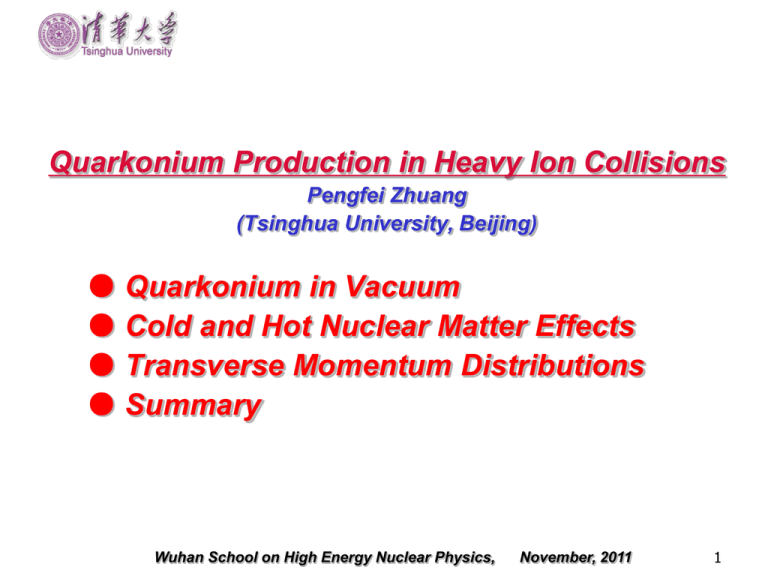
Quarkonium Production in Heavy Ion Collisions Pengfei Zhuang (Tsinghua University, Beijing) ● Quarkonium in Vacuum ● Cold and Hot Nuclear Matter Effects ● Transverse Momentum Distributions ● Summary Wuhan School on High Energy Nuclear Physics, November, 2011 1 Importance of Quarkonium in Studying QGP How to probe QGP? ●electro-magnetic signals (leptons and photons) ●jets (fast partons) ●quarkonium ●heavy quarks are produced only in the initial impact, and no extra production in the later evolution a clean probe of QGP ●production via pQCD process rather solid ground 2 Quarkonium in Vacuum Potential Model in Vacuum Schroedinger equation for heavy QQ system 1 2 2 V r 1 2 2m (r1 , r ) E (r1 , r ), c r r1 r2 radial equation n the rest frame of quarkonium 1 1 d2 l (l 1) r V ( r ) nl Rnl ( r ) 0 2 2 r mc r dr Cornell potential c V (r ) r r boundary condition R(0) , R() 0 three parameters c 0.29, (0.18 GeV) 2 , by fitting the quarkonium masses M 1 M J / , solution M 2 M ' , M3 m c 1.84 GeV M n 2mc n binding energy nl and radial wave function Rnl (r ) r J / 0.5 fm 4 Debye Screening in QGP medium effects on QQ potential: 1) string tension (T ) , in deconfinement phase (T Tc ) 2) charge rearrangement Debye screening the charge density seen by Coulomb potential c c becomes small Yukawa potential r Debye screening length D Debye screening mass mD 6 1 , 2 g q eq T D 1 1 , T N Nc f g 2 3 6 0 c r e r / D 1/ mD Abelian approximation pQCD with colored gluons 5 Estimation of Quarkonium Dissociation Temperature 2 c r / D p Hamiltonian of the QQ system at T > Tc: H e mc r from uncertainty relation p 2 1/ r 2 c r / D 1 e 2 mc r r average energy E stability condition dE 0, dr c (1 r / D )e r / D 2 0 3 2 mc r r constraint to the minimum 2 D (T ) 0.84 c mc dissociation temperature 2 D (TD ) 0.84 c mc with pQCD calculated D (T ) TD 209 MeV for J/ 6 TD in Potential Model Lattice calculated free energy F for a pair of QQ slow dissociation F , V ( r , T ) potential U F TS , rapid dissociation Schroedinger equation at finite T average distance r (T ) binding energy (T ) dissociation temperature: r (TD ) , (TD ) 0 for V=U (Satz et al) T sequential suppression 7 Cold and Hot Nuclear Matter Effects Hot Nuclear Matter effects: 1)suppression in QGP and HG 2)regeneration in QGP and HG Hot Nuclear Matter effects Cold Nuclear Matter effects screening only Cold Nuclear Matter effects: 1)nuclear absorption 2)Cronin effect 3)shadowing effect screening + regeneration ● initial production controls high pt region ●regeneration becomes important at low pt due to heavy quark energy loss 8 Nuclear Absorption in pA Collisions Matsui and Satz, 1986: J/ψ suppression as a probe of QGP in AA collisions Nuclear Modification Factor: J / AA J / c pp RAA N 1, no medium effect <1, J / sup pression >1, J / enhancement However, 1) suppression is observed in pA collisions where QGP is not expected ! 2) J/ψ and ψ’ have the same suppression ! theoretical explanation: nuclear absorption energy dependence of nuclear absorption: J/ formation time f c 0.5 fm collision time c 2 RA / c h yc SPS RHIC LHC abs abs abs 9 Cronin Effect Cronin effect: gluons multi scattering with nucleons before they fuse into a cc pair. transverse momentum broadening ! 2 t p pA p 2 t pp 2 gN t gN p 0 L 10 Shadowing Effect parton distribution function (PDF) in a nucleus is different from a simple superposition (Glauber model) of the PDF in a free nucleon. shadowing correction factor: x: momentum fraction, F : transverse momentum S abs usual PDF shadowing effect + nuclear absorption can explain the pA data at RHIC energy. 11 Normal Suppression at SPS NA38 mechanism: multi-scattering between J/psi and spectator nucleons R.Vogt, Phys.Rept.310, 197(1999) C.Gerschel, J.Hufner, Annu.Rev.Nucl.Part.Sci. 49, 225(1999) abs 6.5 1.0 mb conclusion: nuclear absorption can well explain the J/psi yield in pA and light nuclear collisions at SPS energy ! 12 Anomalous Suppression at SPS (1) anomalous suppression in heavy ion collisions ! model 1: Debye screening (Matsui & Satz, 1986) NA38 at T=0 at T≠ 0 charmonium dissociation temperature (Karsch, Kharzeev, Satz, PLB637, 75(2006) Asakawa & Hatsuda, 2004 Kaczmarek et al., hep-lat/0312015 13 Anomalous Suppression at SPS (2) model 2: threshold model (Blaizot, Dinh, Ollitrault, PRL85, 4010(2000) model 3: comover interaction (Capella, Feireiro, Kaidalov, PRL85, 2080(2000) dynamic processes: J / meson D D geometric fluctuations 14 J/ψ Puzzles at RHIC 2 puzzles for J/Psi production at RHIC energy: RAA (|y|<0.35) > RAA (1.2<|y|<2.2) RAA (RHIC, |y|<0.35) ≈ RAA (SPS) with the Debye screening theory, the suppression is controlled only by the temperature, higher T stronger suppression, it leads to RAA (|y|<0.35) < RAA (1.2<|y|<2.2) RAA (RHIC, |y|<0.35) < RAA (SPS) how to explain the puzzles ? 15 Regeneration at RHIC (1) there are about 10 pairs of c quarks in a central Au-Au collision at RHIC energy and more than 100 pairs at LHC energy very important J/\psi regeneration at high energies: in QGP c c J / g in hadron gas mesons the competition between J/\psi suppression and regeneration leads to the question: J/\psi suppression or enhancement at high energies? model 1: sudden production (Andronic, PBM, Redlich, Stachel, NPA789, 334(2007): J/\psi’s are statistically produced at T=Tc, no initial production suppression at RHIC, no suppression at LHC ! 16 Regeneration at RHIC (2) model 2: continuous production in QGP (Thews, Mangano, PRC73, 014904(2006): J/\psi’s are continuously produced in the whole QGP region including anomalous suppression no initial production * perturbative calculation with nonrelativistic Coulomb potential (Peskin, Bhanot, NPB156, 365(1979) * detailed balance model 3: two-component model (Grandchamp, Rapp, Brown, PRL92, 212301(2004): initial production + sudden regeneration the stronger regeneration at RHIC than at SPS explains the first J/psi puzzle ! the stronger regeneration at central rapidity that at forward rapidity explains the second J/\psi puzzle ! 17 Is Regeneration Necessary ? heavy quark potential (Young, Shuryak, 2008): V = U, F=U-TS Schroedinger equation: J/psi dissociation temperature Td = 2.7 Tc > maximum T at RHIC. there is no big difference between SPS and RHIC ! this explains why there is no big difference between the suppressions at SPS and at RHIC. regeneration looks not necessary !? 18 62 GeV 39 GeV SQM2011 experimental summary by K.Safarik: overall suppression of J/ψ is nearly identical between SPS, RHIC & LHC ! Transverse Momentum Distribution the transverse momentum distribution which depends more directly on the production mechanism must contain additional information about the nature of the medium and J/\psi and may help to distinguish between different scenarios. SPS RHIC LHC (model) A Full Transport Approach for Quarkonia in HIC Tsinghua Group, 2005-2011 ● QGP hydrodynamics + equation of state (ideal gas or strongly coupled matter from lattice) ●quarkonium transport equations ( J / , ', c ) α: suppression β: regeneration ● analytic solution ●initial production f ( p, x , t0 ) , including CNM. Dissociation Cross Section J / () g Q Q ● gluon dissociation cross section described by OPE (Bhanot, Peskin,1999): ( p , pg ) ● at finite temperature, we use the classical relation ( p , pg , T ) r 2 (T ) 2 r (0) ( p , pg ) r 2 (T ) is calculated through the Schroedinger equation ● dissociation rate of at a fixed medium velocity v=0.5 and for V=U: 1)T-dependence of the differential cross section is still an open problem; 2) we did not consider quasifree processes which may play an important role at high T<Td. ● regeneration rate is determined by the detailed balance Transverse Momentum at SPS J.Hufner and PZ, PLB2002,2003 no regeneration at SPS very important leakage effect ! 23 J/ψ RAA ( pt ) at RHIC Y.Liu, Z.Qu, N.Xu, PZ, PLB2009 the competition between initial production and regeneration leads to a minimum, a signature for the coexistence of both production mechanisms. 0 0.6 fm, T0 344 MeV , ppJ / 0.74b, ccpp 0.12nb (PHENIX pp data) at mid rapidity J/ψ Rapidity Dependence at RHIC Y.Liu, N.Xu, PZ, JPG2010 less regeneration in forward rapidity explains the two puzzles naturally. J / pp 0.42b, ccpp 0.04nb at forward rapidity J/ψ RAA ( Np ) at high pt at RHIC STAR data, QM2011 high pt particles can survive in hot medium. centrality dependence of J/ψ RAA ( pt ) at RHIC STAR data, QM2011 more suppression in central collisions J/ψ RAA ( Np ) at LHC ALICE PHENIX more regeneration at LHC RAA RAA 0 0.6 fm, T0 430 MeV (Hirano, Heinz), ppJ / 2.33b (arXiv:1107.0137), ccpp 3.45nb (total, QM2011 talk by Dainese) J/ψ RAA ( Np ) at high pt at LHC ALICE CMS more regeneration at low pt RAA RAA 0 0.6 fm, T0 484 MeV (Hirano, Heinz), J / d pp / dy 3.5 b (arXiv:1107.0137) Averaged Transverse Momentum SPS: Cronin effect RHIC: competition between the two sources LHC: dominant regeneration J/psi elliptic flow at RHIC our prediction: L.Yan, N.Xu, PZ, PRL2006 impact parameter b=7.8 fm STAR data, QM2011 almost no J/psi V2 at RHIC ! J/psi elliptic flow at LHC K.Zhou, N.Xu, PZ, NPA2010 our prediction at \sqrt s = 5.5 TeV and b=7.8 fm : remarkable v2 at LHC ! Υ, a Cleaner Probe at RHIC J/ψ : the production and suppression mechanisms are complicated: there are primordial production and nuclear absorption in the initial state and regeneration and anomalous suppression during the evolution of the hot medium. Υ: 1) the regeneration can be safely neglected; 2) there is almost no feed-down forΥ ; 3) weaker CNM effect Υat RHIC: RAA( Np ) Y.Liu, B.Chen, N.Xu, PZ,PLB2011 for minimum bias events: PHENIX dada: RAA<0.64 (NPA2009) our result: RAA = 0.63 for V=U RAA= 0.53 for V=F ●from the comparison with data, V is close to U. Υat LHC: RAA( Np ) pp 14b, bb pp 43nb ●again, V is close to U. History theory 1986,Matsui and Satz: J/ψ suppression as a probe of QGP experiment 1989, pA and light nuclear collisions at SPS: J/ψ normal suppression 2 puzzles: suppression already in pA, and the same suppression for J/ψ and ψ’. nuclear absorption 1996, Pb-Pb at Elab=200 A GeV at SPS: J/ψ anomalous suppression Debye screening in QGP, hadrom gas model, cold nuclear matter effect, …… 2006, Au-Au at s 200 A GeV at RHIC 2 puzzles: RAA (|y|<0.35) > RAA (1.2<|y|<2.2) regeneration RAA (RHIC, |y|<0.35) ≈ RAA (SPS) 2010, Pb-Pb at LHC RHIC! RHIC! and LHC! LHC! LHC! New data mean new surprises ! 36 many other open questions ● medium effect on charm quark and charmonium strongly coupled QGP, chiral symmetry restoration, critical behavior, mass, width, binding energy,...... ● charm quark potential between free energy F=U-TS and internal energy different dissociation temperature (from Schroedinger equation) ● cold nuclear matter effect (parton distribution) ● charm quark production in QGP ● ...... 37 Dependence on EoS J/Psi Pt distribution at LHC where EoS plays an essential role! wQGP sQGP Only Cold Nuclear Matter Effect ? Υat RHIC: RAA( pt ) Liu, Chen, Xu, Zhuang: arXiv:1009.2585,PLB2011 central Au+Au at √s=200 GeV ● strong Cronin effect Υat RHIC: pt2 ( N p ) relation between ϒ at RHIC and J/ψ at SPS: ● no ϒ regeneration at RHIC and no J/ψ regeneration at SPS no ϒ(1s) suppression at RHIC TD (1s ) 4Tc TRHIC ● no J/ψ suppression at SPS TDJ / 2Tc TSPS both are controlled by the Cronin effect ! pt2 pt2 2 RHIC t p AA pt2 RHIC agN RAu a SPS gN RPb pp agN L 2 SPS t J / p 2 SPS t J / 2.4 p Au+Au at √s=200 GeV Liu, Chen, Xu, Zhuang: arXiv:1009.2585,PLB2011 Measuring RHIC Temperature by Excited ϒ States initial temperature dependence of RAA central Au+Au at √s=200 GeV Liu, Chen, Xu, Zhuang: arXiv:1009.2585,PLB2011 suppression of excited ϒ states is sensitive to the fireball temperature ! Υat LHC: RAA( pt ) high pt is controlled by initial production ! Conclusions: ● pt dependence is more sensitive to the production and suppression mechanism. ● regeneration is important at RHIC and LHC. ● competition between initial production and regeneration can explain systematically the data from SPS to LHC. ● Upsilon production at RHIC and LHC supports V=U. Uncertainty analysis: pp collision, shadowing effect, EoS, time scales, …… Suggestions: ● measure D-Dbar correlation at LHC (Zhu, Bleicher, Huang, Schweda, Stoecker, Xu, Zhuang, PLB2007, Zhu, Xu, Zhuang, PRL2008) ● measure J/psi-D correlation at LHC (since both are from the same source ) ● measure quarkonium v2 at LHC (which is very sensitive to the production and suppression mechanisms ). 45 Charmonium in pp Collisions pp ' X B ( ' ) observation: J / , ' , 1.5% pp J / X B( J / ) difficult to observe ψ’ ! Ψ’ and χc decay into J/ψ: P ( c J / ) 30% Ψ’ χc P ( ' J / 2 ) 10% direct production J/ψ mechanisms for quarkonium production in pp: 60% it is difficult to describe quarkonium formation due to confinement problem 1) color evaporation model: color evaporation gg colored cc J / 2) color-singlet model: gg cc J / g 3) color-octet model: gg cc n X n n: quantum numbers of color, angular momentum and spin 46 near side DD correlation at LHC Zhu, Xu, Zhuang, PRL100, 152301(2008) * c quark motion in QGP: for strongly interacting quark-gluon plasma: we take drag coefficient to be a parameter charactering the coupling strength * QGP evolution: ideal hydrodynamics ● at RHIC, the back-to-back correlation is washed out. ● at LHC, c quarks are fast thermalized, the strong flow push the D and Dbar to the near side! large drag parameter is confirmed by R_AA and v_2 of non-photonic electrons (PHENEX, 2007; Moore and Teaney, 2005; Horowitz, Gyulassy, 2007). ATHIC III at Wuhan, October, 2010 47
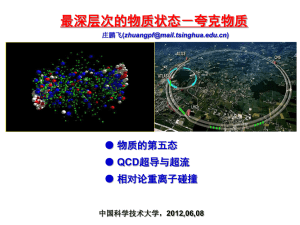
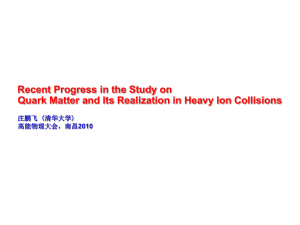
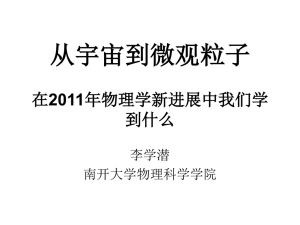
![Lecture 3 [pptx] - Triangle Universities Nuclear Laboratory](http://s2.studylib.net/store/data/005775243_1-37c3b33c412a7530285b46f51206c4ad-300x300.png)
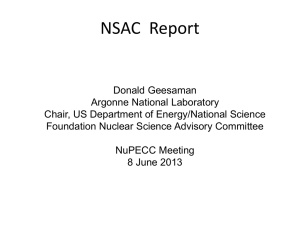

![Lecture 2 [pptx]](http://s2.studylib.net/store/data/005701299_1-088c5fa4ce0efec34ca2ccadec17d15f-300x300.png)


